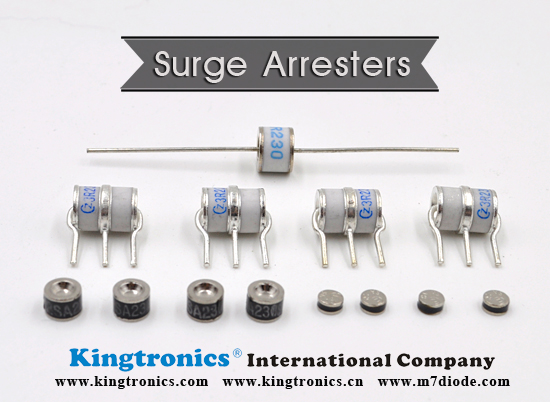Kingtronics offers Chip Multilayer Ceramic Capacitors from low voltage (LKT)to high voltage(HKT)
5 Jan 2011A capacitor is a passive electronic component consisting of a pair of conductors separated by a dielectric.
Kingtronics specializes in application specific multilayer ceramic capacitors. Our product offerings included surface mount capacitors from the 0402 case size to larger high voltage units (up to 4KV) for Commercial and High Reliability applications.
The NPO model from Kingtronics International Company is a series of multilayer chip-type ceramic capacitors that has 0.5pF to 10uF capacitance, with up to 10 percent tolerance.
The 0805-packaged MLCC is rated at 6.3V to 50V for low voltage chip ceramic capacitor and from 63V to 4kV for high voltage multilayer ceramic capacitor.
Our products LKT Chip multilayer ceramic capacitors 6.3V to 50V and HKT High voltage multilayer ceramic capacitors 63V to 4000V are marketed under our own brand "Kingtronics" and enjoy a very good reputation around the world. Many customers approved our product brand "Kingtronics" and appointed to order.

- 0Commentary
- Tags:
Kt Kingtronics What is Quartz Used for?
5 Jan 2011Quartz is used in the making of sandpaper, optics, glass, liquid filters, circuit boards, computer components, cement, mortar, and jewelry. Quartz crystals are also piezoelectric meaning when an electrical current passes through them they vibrate a small amount. Time can be measured from the vibrations of the quartz crystals so quartz crystals are often used in clocks.
Quartz crystals may either operate in a fundamental mode or in an overtone mode. Below frequencies of around 25 MHz crystals are normally designed to operate in their fundamental mode, whereas above this they will normally be designed for overtone operation, although with manufacturing techniques improving higher frequency crystals are becoming available. The mode is therefore an important element of the crystal specification.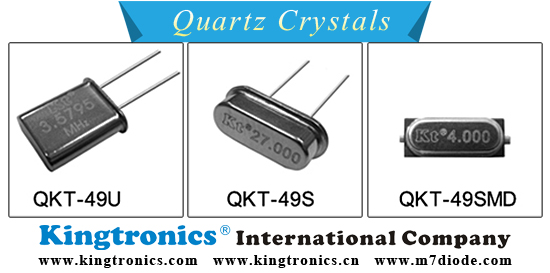
Kingtronics trimming potentiometer 3006, 3266, 3296, 3323, 3329, 3362, 3386,3309, 3540, 3590 ("King Mark")
25 Dec 2010A trimmer or preset[1] is a miniature adjustable electrical component. It is meant to be set correctly when installed in some device, and never seen or adjusted by the device's user. Trimmers can be variable resistors (potentiometers), variable capacitors, trimmable inductors. They are common in precision circuitry like A/V components, and may need to be adjusted when the equipment is serviced. Unlike many other variable controls, trimmers are mounted directly on circuit boards, turned with a small screwdriver and rated for many fewer adjustments over their lifetime. Trimmers like trimmable inductors and trimmable capacitors are usually found in superhet radio and television receivers, in the Intermediate frequency, oscillator and RF circuits. They are adjusted into the right position during the alignment procedure of the receiver.
Trimmers come in a variety of sizes and levels of precision; for example, multi-turn trim potentiometers exist, in which it takes several turns of the adjustment screw to reach the end value, allowing for very high degrees of accuracy.
Since 1990 , Kingtronics International company founded its first factory in mainland of China . For 20 years development and experience in manufacturing timpots , Kingtronics brand is well known by more and more pepole .
Now Kingtronics offer Bourns equivalence: 3006, 3266, 3296, 3323, 3329, 3362, 3386,3309, 3540, 3590 . If you want more details ,please visit website: www.kingtronics.com for full specification.
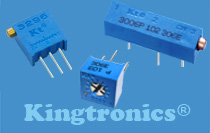
- 0Commentary
- Tags:
Kt Kingtronics Surge Arresters Application
24 Dec 2010Lightning Arresters are protective devices for limiting surge voltages due to lightning strikes or equipment faults or other events, to prevent damage to equipment and disruption of service. Also called surge arresters.
Lightning Arresters are installed on many different pieces of equipment such as power poles and towers, power transformers, circuit breakers, bus structures, and steel superstructures in substations.
Lightning arrester on distribution pole transformer:

Kingtronics is one HK based manufacturer for electronics component since 1990. Now Kingtronics is an old brand and we also have enjoyed high reputation in electronics component field, especially for radial and axial multilayer ceramic capacitor!
Now fewer and fewer factories produce radial & axial lead mono capacitors, while Kingtronics still keep strong on radial multilayer ceramic capacitors and axial lead,
We have excellent support on radial MLCC capacitor,
***3-4 weeks delivery
***unbeatable price
***stable and high quality
***low MOQ
In case you have any inquiry for radial and axial multilayer ceramic capacitor, please feel free to contact us: info@kingtronics.com
MKT--Radial multilayer ceramic capacitor (mono cap)
0.1uF 50V Y5V +/-20% P:2.54mm Bulk RoHS
4700pF 50V +/-10% X7R P: 2.54mm Bulk RoHS
100pF 50V NPO +/-5% P: 2.54mm Bulk RoHS
AKT--axial lead, multilayer ceramic capacitors
0.1uF 50V +80-20% Y5V Ammo RoHS
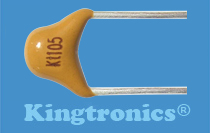
- 0Commentary
- Tags:
Trimming Potentiometer introduction
22 Dec 2010There are Trimming Potentiometer (aka trimmers) - pots designed for "set and forget" applications. They are used for "trimming" the value of a resistor, and are commonly used for calibrating instruments, setting the bias current on power amplifiers, and a host of other areas where a circuit cannot be relied upon to give an exact gain, output voltage, or current. Naturally, a normal panel pot can be used, but these are very much bigger, and any calibration or setup control should not be made available for everyone to fiddle with as they please.

This is a very small sample of those available. The first and fourth are multi-turn types, and these should be used when a very precise setting is required. Because they are sealed, they are relatively immune from contamination, and for all but the most trivial application, should be used instead of the open types. Trimming Potentiometer(as shown) are generally available as vertical or horizontal - the choice is usually made based on ease of adjustment of the final circuit.
- 0Commentary
- Tags:
Kt Kingtronics Diode M7 (S1M GS1M) SMA, LL4148 MINIMELF, SM4007 Melf, BZV55C MINIMELF, 1N4007 DO-41 RoHS
21 Dec 2010Diode rectifier M7: Lead time: 3-4 weeks
Price is much better than Diotec, Panjit, Vishay, Onsemi...
Welcome to send inquiry to us!
Diode Package:
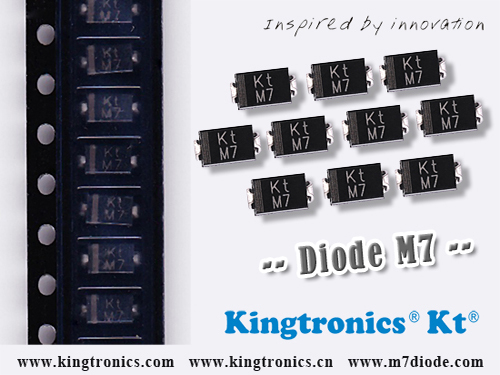
Last shortage of tantalum capacitors happened in 2000, this year 2010, tantalum shortage happened again. It seems every 10 years, tantalum capacitors shortage happens.
AVX TAP series is dipped tantalum capacitors, their lead time is more than 50 weeks. Vishay announce of allocation of dipped tantalum capacitors. Kemet's lead time are very long too.
Kingtronics also face the same problem of tantalum powder shortage and tantalum wire shortage, however, our delivery situation are slowly improving. Especially dipped tantalum capacitors, sometimes we have stock.
Please visit our website: http://www.kingtronics.com/tantalum-capacitors/
You can download our tantalum datasheet and cross reference. Welcome to send us inquiry for tantalum capacitors: info@kingtronics.com
- 0Commentary
- Tags:
Kt Kingtronics Surge Arresters Applications
18 Dec 2010Gas-filled surge arresters are classical components for protecting the installations of the telecommunications. It is essential that IT and telecommunications systems -with their high-grade but sensitive electronic circuits – be protected by arresters. They are thus fitted at the input of the power supply system together with varistors and at the connection points to telecommunication lines. They have become equally indispensable for protecting base stations in mobile telephone systems as well as extensive cable television (CATV) networks with their repeaters and distribution systems.
These protective components are also indispensable in other sectors:
- In AC power transmission systems, they are often used with current-limiting varistors
- In customer premises equipment such as DSL modems,WLAN routers, TV sets and cable modems
- In air-conditioning equipment
The integral black-box concept offers graduated protection by combining arresters with varistors, PTC thermistors, diodes and inductors to create an ideal solution for many applications.
Contact us
Tel: (86) 769 8118 8110
Tel: (852) 8106 7033
Fax: (852) 8106 7099
E-mail: info@kingtronics.com
Microsoft Teams: Kingtronics.sales via Teams
Web: www.Kingtronics.com
YouTube: www.youtube.com/c/Kingtronicskt
About
Kingtronics International Company was established in 1995 located in Dongguan City of China to handle all sales & marketing for factories located in Chengdu, Sichuan and Zhaoqing, Guangdong, China. In 1990, we established the first factory to produce trimming potentiometer and in 1999 we built up new factory in Zhao Qing, Guangdong. Now with around 850 workers, Kingtronics produce trimming potentiometers, dipped tantalum capacitors, multilayer ceramic capacitors, and diode & bridge rectifier. We sell good quality under our brand Kingtronics, and Kt, King, Kingtronics are our three trademarks. All our products are RoHS compliant, and our bridge rectifier have UL approval. Please visit our Products page, you could please download all our PDF datasheet and find cross reference for our Trimming Potentiometer and capacitors.
Tantalum and Ceramic Capacitors Cross Reference ↓ Download
Diodes & Rectifiers List(PDF: 97KB) ↓ Download
Trimming Potentiometer Cross Reference ↓Download
Categories
- Kt Kingtronics (245)
- Diodes & Rectifiers (161)
- Aluminum Electrolytic Capacitor (161)
- Trimming Potentiometers (128)
- Tantalum Capacitors (96)
- Multilayer Ceramic Capacitors (70)
- Quartz Crystals (64)
- Kt Bridge Rectifier (64)
- Film Capacitors (35)
- Surge Arresters (34)
- Tactile Switches (32)
- Kt Kingtronics Components (30)
- Ceramic Trimmer Capacitors (26)
- Super Capacitors (19)
- Metal Oxide Varistor (12)
- Negative Temperature Coefficient Thermistor (6)
- Special Purpose Film Capacitors (3)
- Music capacitors (2)
Archives
- 2025 April (2)
- 2025 March (3)
- 2025 February (3)
- 2025 January (4)
- 2024 December (2)
- 2024 November (5)
- 2024 October (4)
- 2024 September (6)
- 2024 August (9)
- 2024 July (6)
- 2024 June (5)
- 2024 May (3)
- 2024 April (3)
- 2024 March (2)
- 2024 February (2)
- 2024 January (3)
- 2023 December (1)
- 2023 November (2)
- 2023 October (1)
- 2023 September (2)
- 2023 August (2)
- 2023 July (4)
- 2023 June (12)
- 2023 May (6)
- 2023 April (4)
- 2023 March (3)
- 2023 February (2)
- 2023 January (1)
- 2022 December (3)
- 2022 November (2)
- 2022 October (3)
- 2022 September (4)
- 2022 August (3)
- 2022 July (3)
- 2022 June (2)
- 2022 May (3)
- 2022 April (4)
- 2022 March (4)
- 2022 February (2)
- 2022 January (3)
- 2021 December (4)
- 2021 November (3)
- 2021 October (4)
- 2021 September (4)
- 2021 August (4)
- 2021 July (4)
- 2021 June (5)
- 2021 May (4)
- 2021 April (3)
- 2021 March (4)
- 2021 February (4)
- 2021 January (4)
- 2020 December (5)
- 2020 November (4)
- 2020 October (4)
- 2020 September (7)
- 2020 August (8)
- 2020 July (9)
- 2020 June (8)
- 2020 May (9)
- 2020 April (11)
- 2020 March (6)
- 2020 February (4)
- 2020 January (4)
- 2019 December (6)
- 2019 November (7)
- 2019 October (6)
- 2019 September (5)
- 2019 August (9)
- 2019 July (6)
- 2019 June (4)
- 2019 May (16)
- 2019 April (6)
- 2019 March (6)
- 2019 February (9)
- 2019 January (5)
- 2018 December (4)
- 2018 November (4)
- 2018 October (5)
- 2018 September (8)
- 2018 August (10)
- 2018 July (7)
- 2018 June (12)
- 2018 May (22)
- 2018 April (4)
- 2018 March (4)
- 2018 February (8)
- 2018 January (13)
- 2017 December (4)
- 2017 November (4)
- 2017 October (5)
- 2017 September (4)
- 2017 August (20)
- 2017 July (7)
- 2017 June (5)
- 2017 May (4)
- 2017 April (4)
- 2017 March (8)
- 2017 February (8)
- 2017 January (8)
- 2016 December (10)
- 2016 November (16)
- 2016 October (8)
- 2016 September (10)
- 2016 August (13)
- 2016 July (12)
- 2016 June (10)
- 2016 May (14)
- 2016 April (8)
- 2016 March (10)
- 2016 February (6)
- 2016 January (8)
- 2015 December (10)
- 2015 November (8)
- 2015 October (3)
- 2015 July (5)
- 2015 June (9)
- 2015 May (7)
- 2015 April (8)
- 2015 March (9)
- 2015 February (7)
- 2015 January (5)
- 2014 December (13)
- 2014 November (4)
- 2014 October (4)
- 2014 September (5)
- 2014 August (4)
- 2014 July (4)
- 2014 June (4)
- 2014 May (4)
- 2014 April (4)
- 2014 March (5)
- 2014 February (3)
- 2014 January (4)
- 2013 December (8)
- 2013 November (9)
- 2013 October (10)
- 2013 September (9)
- 2013 August (11)
- 2013 July (10)
- 2013 June (3)
- 2013 May (4)
- 2013 April (3)
- 2013 March (2)
- 2013 February (1)
- 2013 January (3)
- 2012 December (5)
- 2012 November (6)
- 2012 October (5)
- 2012 September (10)
- 2012 August (11)
- 2012 July (11)
- 2012 June (12)
- 2012 May (14)
- 2012 April (9)
- 2012 March (14)
- 2012 February (9)
- 2012 January (6)
- 2011 December (9)
- 2011 November (11)
- 2011 October (10)
- 2011 September (13)
- 2011 August (14)
- 2011 July (13)
- 2011 June (13)
- 2011 May (13)
- 2011 April (14)
- 2011 March (27)
- 2011 February (13)
- 2011 January (24)
- 2010 December (21)
- 2010 November (12)
- 2010 October (11)

